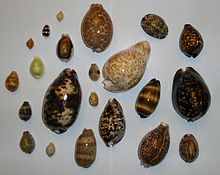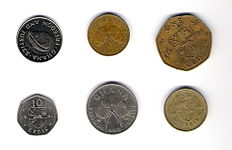Cedi
| Cedi | |
|---|---|
| Country: |
|
| Subdivision: | 100 pesewas |
| ISO 4217 code : | GHS |
| Abbreviation: |
|
|
Exchange rate : (29 Mar 2020) |
1 EUR = 6.2956 GHS 1 CHF = 5.8504 GHS |
The Cedi is the official currency of Ghana . It is divided into 100 pesewas . Its ISO abbreviation is GHS , the currency symbol ![]() ( Unicode : U + 20B5 cedi sign ). The name Cedi is derived from the Akan word for Kauri - "sedie". Cowries were currency in West Africa from the 15th century to the beginning of the 20th century .
( Unicode : U + 20B5 cedi sign ). The name Cedi is derived from the Akan word for Kauri - "sedie". Cowries were currency in West Africa from the 15th century to the beginning of the 20th century .
history

| time | currency | Subunit | Exchange rate | coupling |
|---|---|---|---|---|
| 1958-1965 | Ghanaian pound | 20 shillings, 140 pence | 1: 2.4 | |
| 1965-1967 | First cedi | 100 pesewas | 1.2: 1 | £ 1 = 2.4 cedi |
| 1967-2007 | Second cedi (GHC) | 100 pesewas | 10,000: 1 | 1 £ = 2 GHC |
| 2007– | Third cedi (GHS) | 100 pesewas |
1965 to 1967 - First Cedi
On Monday, July 19, 1965, the Cedi was introduced as the official currency in Ghana, which had become independent eight years earlier. It replaced the West African pound (£ G), a decimal currency , in the ratio of £ 1.00 G = 2.40 Cedi. The new currency was pegged to the British pound at a rate of 2.40 cedi = £ 1 .
Historical rates of the first cedi
- 1957 - July 19, 1965: 1 Ghanaian pound (£ G) = 1 British pound sterling (£)
- July 19, 1965 - February 1967: 1 Cedi = 8 s. 4 d. (British) or $ 1 = 85.71 Pesewas
1967 to 2007 - Second Cedi
After the fall of Kwame Nkrumah in 1966, the Second Cedi (ISO abbreviation: GHC ) was introduced on February 23, 1967 . Reasons for this were the expediency of the exchange and the desire to remove Nkrumah's portrait from coins and banknotes. The exchange rate was 1 GHC = 1.20 old Cedi and thus 2 GHC = £ 1.
Historical rates of the second cedi
- February 1967 - July 1967: 1 New Cedi = 10 s. sterling (brit.) or $ 1.40 = 71.43 pesewas
- July 1967 - November 1967: £ 1 (GBP) = 2.857 new cedi or $ 1 (USD) = 1.0204 new cedi
- November 1967 - August 1971: 1 New Cedi = 8 s. 2 d. or 1 New Cedi = 40.83 New Pence (brit.)
- December 1971 - February 1972: GBP 1 = 4.738 New Cedi or USD 1 = 1.8182 New Cedi
- June 1972 - February 1973: GBP 1 = 3.335 New Cedi or USD 1 = 1.28 New Cedi
- February 1973 - June 1978: $ 1 = 1.15 New Cedi or 1 Cedi = 86.96 US cents
- August 1978: $ 1 = 2.75 New Cedi or 1 New Cedi = 36.36 US cents
- median rate for 1984: 1 USD = 35.34 GHC
- Median rate for 1985: USD 1 = 54.05 GHC
- median rate for 1986: $ 1 = 89.29 GHC
- Average rate for 1989: $ 1 = GHC 270.00
- median rate for 1990: 1 USD = 326.33 GHC
- Median rate for 1991: USD 1 = 367.28 GHC
- Average rate for 1992: $ 1 = 437.09 GHC (estimate)
- Median rate for 1993: USD 1 = GHC 649.06
- Average rate for 1996: 1 USD = 1,637.23 GHC
- Median exchange rate for 1997: 1 USD = 2,050.17 GHC
- Average rate for 1998: USD 1 = 2,314.15 GHC
- Average rate for 1999: USD 1 = 2,647.32 GHC
- Median rate for the year 2000: 1 USD = 5,526.61 GHC
- Average rate for 2001: USD 1 = 7,170.75 GHC
- Average rate for 2002: USD 1 = 7,932.70 GHC
- median rate for 2003: $ 1 = 8,677.37 GHC
- Average rate for 2004: 1 USD = 8,915.19317 GHC
- Average rate for 2005: 1 USD = 9,074.09488 GHC
- median rate for 2006: 1 USD = 9,445.24378 GHC
- Median rate for 2007: 1 USD = 9,607.96389 GHC
2007 to date - Third Cedi
On July 1, 2007 there was a new introduction of the Cedi in Ghana. The old cedi (ISO 4217 code: GHC ) was devalued 10,000: 1 (four zeros deleted) and the new Ghana cedi (ISO 4217 code: GHS ) was based on a 1: 1 basis against the US dollar. The Ghana Cedi is divided into 100 Ghana Pesewas .
For a transitional period of six months, both old and new Cedi were valid in parallel as circulating currency in daily transactions with private end consumers. As of December 31, 2007, the old Cedi is no longer valid.
The Ghanaian government hoped that the introduction of the Cedi would have a positive effect on the environment of macroeconomic stability and referred in advance to countries such as Brazil , Argentina , Mexico and Turkey , which had had positive experiences with similar programs in the past. After the announcement of the measure, fears were expressed that it could lead to losses similar to those after the massive cedi devaluation in 1979. However, the representatives of the Bank of Ghana resolutely opposed this, as the value of the currency was converted to another basis will not be influenced. In particular, the government hoped that this step would reduce the inflation rate and the interest rate for long-term investments. These two criteria in particular are extremely important for those countries that wanted to be involved in the introduction of the Eco in 2009 . Following the example of the euro , the ECO was to be introduced in 2009 as the common West African currency in the countries belonging to the West African currency zone (ECO zone) , to which Ghana has also announced its intention to join.
Third Cedi rate developments
| Annual average rates of the Third Ghanaian Cedi [GHS] | |||||||
|---|---|---|---|---|---|---|---|
| Period | 1 EUR = | 1 USD = | source | ||||
| Bid price | Ask rate | medium | Bid price | Ask rate | medium | ||
| [GHS] | |||||||
| July 1, 2007 - December 31, 2007 | 1.3138 | 1.3641 | 1.3390 | 0.9301 | 0.9655 | 0.9478 | |
| January 1, 2008 - December 31, 2008 | 1.5612 | 1.6116 | 1.5864 | 1.0655 | 1.0987 | 1.0821 | |
| January 1, 2009 - December 31, 2009 | 1.9727 | 2.0228 | 1.9978 | 1.4140 | 1.4469 | 1.4305 | |
| January 1, 2010 - December 31, 2010 | 1.8803 | 1.9239 | 1.9021 | 1.4167 | 1.4491 | 1.4329 | |
| January 1, 2011 - December 31, 2011 | 2.1314 | 2.1720 | 2.1517 | 1.5316 | 1.5604 | 1.5460 | |
| January 1, 2012 - December 31, 2012 | 2.3607 | 2.3987 | 2,3797 | 1.8374 | 1.8665 | 1.8519 | |
| January 1, 2013 - December 31, 2013 | 2.7273 | 2.7683 | 2.7478 | 2.0516 | 2.0820 | 2.0668 | |
Web links
- Previous banknotes of Ghana (view on the website of the Bank of Ghana) (click there on the face value to get a view of the front and back of the banknote.)
- Images of the previous coins of Ghana
Individual evidence
- ↑ Akwaaba - Impressions from Ghana ( German ) In: akwaaba-impressionenausghana.blogspot.com . Retrieved October 18, 2010.
- ↑ a b c d e f g interbank - spot rates according to the OANDA Corp.




